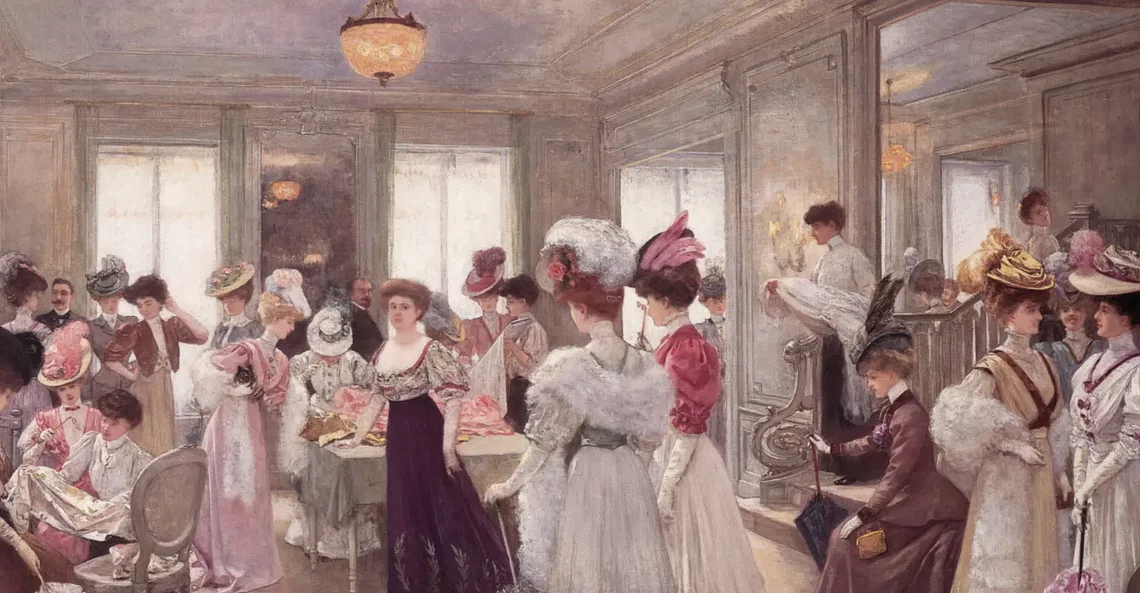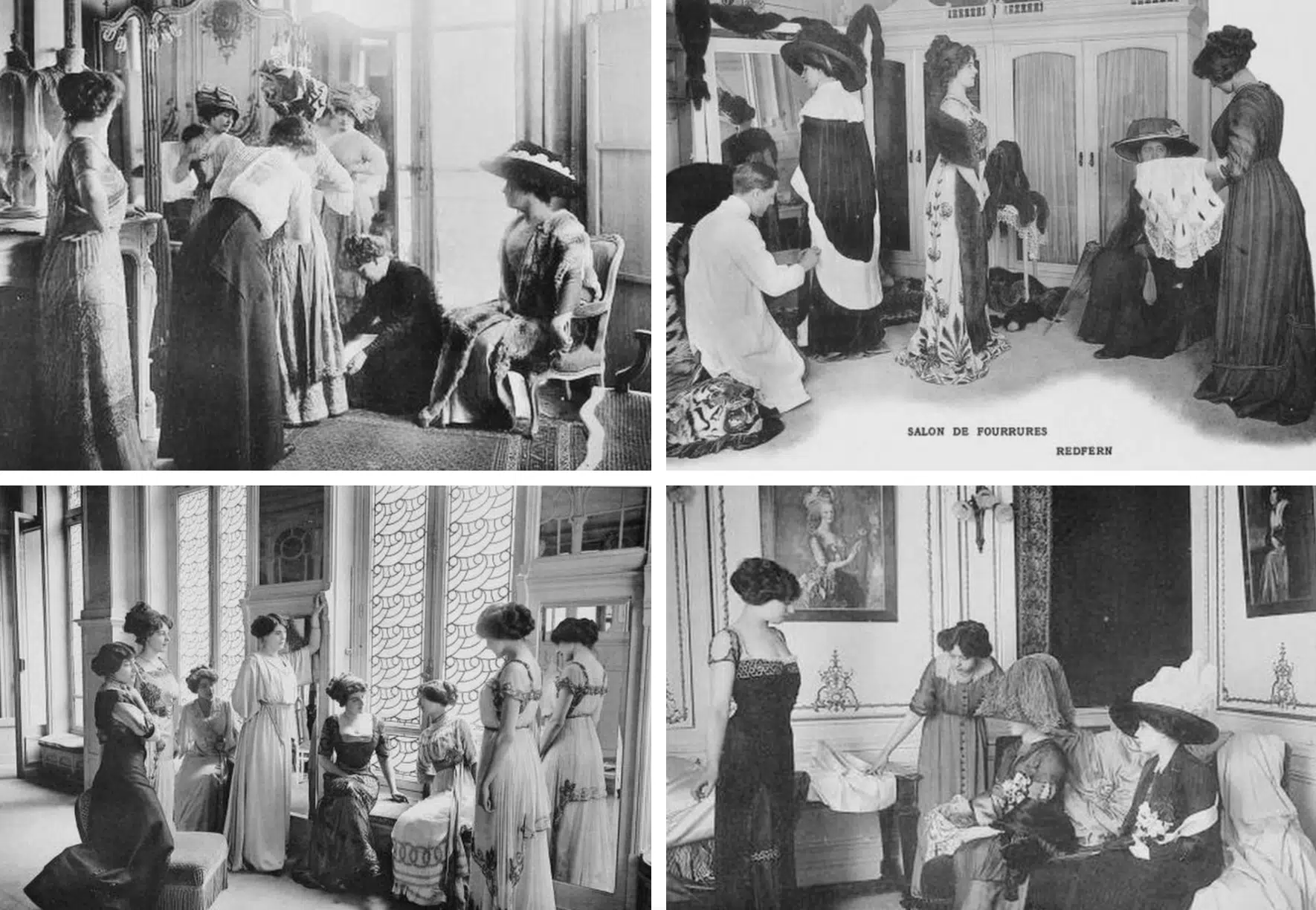The Origins of Haute Couture: from Rue de la Paix to Le Sentier

Tue 22 Feb 2022
I was very apprehensive about embarking on my new adventure as an Haute Couture embroiderer in Paris, I had no idea of whether I would succeed. Honestly, up to this point, I hadn’t had much time to explore the streets or neighbourhoods of Paris but thought it was important to brush up on my Haute Couture geography so that I could start sending out my CVs. École Lesage had furnished me with the basic supplies for Haute Couture Embroidery; a range of crochet hooks, six needles, a small scissors that was surprisingly sharp, a bobbin to hold my threads, and a borrowed thimble I had forgotten to return. But I worried that I would be missing some vital accoutrement if I did manage to get work and wondered where an embroiderer goes to purchase quality supplies in Paris?
I had passed the ateliers of Vermont and Montex, gazing longingly at the brass plaques on their firmly closed doors and knew that Maison Lesage was in Pantin, I could see it from my apartment window. Maison Hurel was actually in my neighbourhood but I didn’t dare visit, intimidated by their impressive history; their family-run embroidery atelier is now in its 5th generation after it was first established at Place de la Bourse in 1879. I was soon to discover that the area surrounding Place de la Bourse is the place to go for embroidery materials and like Maison Hurel, the story begins in 19th century Paris…

19th and early 20th century views of Rue de la Paix with the Houses of Jeanne Paquin, Charles Frederick Worth and Jacques Doucet
The Belle Époque saw the dawn of Haute Couture as Charles Frederick Worth, Jacques Doucet and Jeanne Paquin established their maisons on Rue de la Paix in the 2nd arrondissement of Paris. A short carriage-ride away was Louis Vuitton on Rue Scribe, Redfern on Rue de Rivoli, and the Callot Soeurs on Rue Taitbout. In the early 20th century the next generation of designers followed suit as Elsa Schiaparelli and Madame Grès made Rue de la Paix their home and a short automobile-ride away was Paul Poiret on Avenue d’Antin, Coco Chanel on Rue Cambon and Madeline Vionnet on Rue de Rivoli.

It is no surprise that the suppliers of the luxury houses were to be found in the surrounding areas. Nestled between the grand, tree-lined Haussmannian boulevards of Sebastopol, Poissonnière, Bonne-Nouvelle and Réaumur are the narrow, criss-crossing streets of Sentier. It has been the supplier of the luxury fashion industry since the Napoleonic Empire in the 18th century when the streets were lined merchants and craftspeople catering to the needs of seamstresses, dressmakers, tailors, milliners, embroiderers, feather-workers and artificial flower-makers.
Elegant Parisiennes who perhaps could not afford the extravagance of Maison Worth, Doucet or Paquin would come to the Sentier looking to enhance their wardrobes. In one building they could select their fabrics in the basement, discuss their designs with the tailors and seamstresses in the ateliers upstairs and collect their garments from the boutiques at street level. The foundations for ready-to-wear and then fast-fashion were laid in these efficient systems.
Their fine clothes were made by merchants and craftspeople whose origins tell the inextricably linked history of immigration, colonialisation and the textile trade. The streets of Sentier bustled with immigrants from Alsace and Normandy in France, Armenia and Turkey, Jewish people from Eastern Europe and North Africa. The French Company of the East Indies established their headquarters here, selling printed cottons exported from their colonies in Pondicherry and Chandemanger, India. Even the street names tell the story of the Napoleonic campaign in Egypt; rue d’Aboukir, rue de Caire, rue du Nil, rue d’Alexandrie and the Passage du Caire.
The statue of St. Catherine, patron saint of the Midinettes, the young women who worked in the surrounding Haute Couture ateliers, still stands watch on the corner of rue Cléry and Poissonière. These women also rushed through the streets of Sentier on their way to and from work, signifying the changing roles of women in society with their financial independence and successful demands for labour reforms in the late 19th and early 20th century.
Amongst the throngs of Midinettes was a thirteen year old Jeanne Lanvin who raced across Paris delivering hats for a milliner based on rue Faubourg Saint-Honoré in the early 1880s. After a promising apprenticeship Madame Lanvin opened her own hat shop on the same street before establishing herself as one of the major Haute Couture designers of the early 20th century. I wonder if the young Jeanne ever took a moment between deliveries to peer in the window of Ultramod, a hat shop established in 1832? It was expanded in 1920 to include what is now the oldest haberdashery in Paris and it seemed like a great place to begin my search for embroidery materials…
About the Author Rebecca Devaney:
Join Rebecca on a tour of Paris’ charming haberdasheries nestled deep in the winding streets of Le Sentier, the city’s historic textile and fashion district. Enjoy a Sunday morning with Rebecca on a Flea Market Tour as she guides you through the labyrinth alleys of Paris’ oldest marché-aux-puces to uncover hidden treasure troves filled with vintage lace, linen, passementerie, golden threads and gossamer lingerie. To find out more visit Textile Tours of Paris.